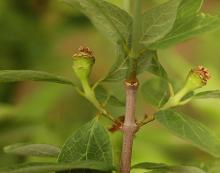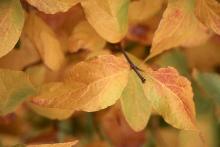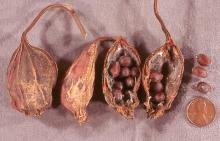Calycanthus floridus
Common name:
Carolina Allspice
Common Sweetbush
Pronunciation:
kal-i-KAN-thus FLOR-i-dus
Family:
Calycanthaceae
Genus:
Type:
Broadleaf
Native to (or naturalized in) Oregon:
No
- Deciduous shrub, 6-9 ft (1.8-2.7 m), greater spread, dense, bushy, rounded, or broad rounded of regular outline (straggly in the wild). Leaves opposite, simple, entire, ovate, elliptic, to narrow-elliptic, 5-12 cm long, half as wide, acute or acuminate, gray green above, pale with dense pubescence beneath. Buds are enclosed by the base of the petiole. Flowers solitary, dark reddish brown, 5 cm wide, very fragrant, blooms in mid to late spring. Fruit capsule-like, containing may seeds (actually achenes).
- Sun or shade. Prefers loamy, moist soils, but is adaptable. Prune after flowering. The nature and intensity of flower fragrance varies from plant to plant if seedling grown, if fact some (most?) may lack an attractive fragrance. It is best to shop for plants when in bloom so the fragrance can be determined.
- Hardy to USDA Zone 5 Native range from Virginia to Florida.
- Grown in American gardens since colonial days for the camphor-like scent of its leaves, wood and roots and the sweet fragrance of its red-brown flowers in summer. Seeds are poisonous, causing convulsions, myocardial depression and hypotension.
- Calycanthus: kalyx (calyx), anthos (flower), reference to similarity of sepals and petals; floridus: flowering
- Oregon State Univ. campus: south of Fairbanks Hall.













